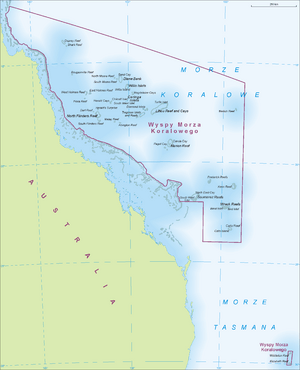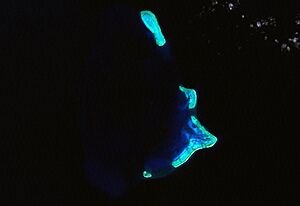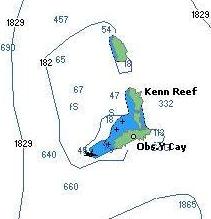Kenn Reef facts for kids
Kenn Reef is a coral reef found in the Coral Sea Islands, off the coast of Queensland, Australia. It's like a giant, underwater L-shaped or boot-shaped area, about 15 kilometers long and 8 kilometers wide. This reef covers about 40 square kilometers. There's a tiny island on the reef called Observatory Cay, which is only about 2 meters above the water at high tide.
Kenn Reef is located over 500 kilometers from the Australian mainland and is part of a large underwater landmass called the Kenn Plateau. Scientists believe this area was formed from volcanic activity and drifted away from Australia millions of years ago. The reef was first discovered on April 3, 1824, by Captain Alexander Kenn, who was sailing the ship William Shand.
Contents
About Kenn Reef
Kenn Reef is a remote reef in the southeastern part of the Coral Sea. It's about 100 kilometers northeast of the Wreck Reefs and 140 kilometers southeast of the Frederick Reefs. The Bellona Reefs of New Caledonia are even further east.
The reef sits on the Kenn Plateau, which is a huge underwater area covering about 100,000 square kilometers. This plateau is very deep, ranging from 1,000 to over 3,000 meters underwater. The Kenn Plateau was formed when parts of the Earth's crust moved apart between 95 and 52 million years ago, creating the Tasman and Coral Sea basins.
Kenn Reef is made up of four main reefs that together look like a backward L-shape or a boot. The three reefs on the southern side are connected, while the northern reef is separated by a deep channel. The smallest reef, on the western side, has a large boulder that looks like part of a shipwreck from a distance.
The largest part of the reef is the southeastern section, which has two sand islands. One of these is Observatory Cay 21°16′S 155°48′E / 21.267°S 155.800°E. It's about 100 meters long, 50 meters wide, and 2 meters high, with a bit of plants growing on it. Most of the reefs are covered by the sea at high tide, except for the southwestern reef. The northern reef has a shallow lagoon inside it.
History of Discovery
Kenn Reef was found on April 3, 1824, by Captain Alexander Kenn. He was sailing his ship, the William Shand, from Sydney to Batavia (which is now Jakarta in Indonesia). Captain Kenn described the reef as being about 10 miles long and 6 miles wide, with some rocks sticking out of the water.
The William Shand was a fast ship built in 1818 in the UK. It was used to carry goods and passengers between the UK, Hobart, and Sydney. Captain Alexander Kenn sadly passed away in 1829 in Van Diemen's Land (now Tasmania).
Famous Shipwrecks on Kenn Reef
Kenn Reef has been the site of several shipwrecks over the years. Here are some of the most well-known:
The Bona Vista
The ship Bona Vista was wrecked on Kenn Reef on March 18, 1828. It was about 280 miles east of Mackay. Captain Robert Towns and his crew spent several weeks stuck on the reef. Luckily, they were eventually rescued by another ship called the Asia.
The Jenny Lind
The Jenny Lind was a wooden ship that crashed into Kenn Reef on September 21, 1850. It was sailing from Melbourne to Singapore with 28 passengers and crew. The ship hit the reef hard and was soon breaking apart.
Everyone managed to get off the ship and onto a small island nearby. They faced a tough challenge: they had very little food and water. A passenger named Mr. Philip Beal, who was a surgeon, became a hero. He found a copper boiler and some pipes from the wreck and used them to distill fresh water from the sea! This was amazing and helped everyone survive.
The shipwrecked people worked together. Some saved useful items from the wreck, others helped Mr. Beal make fresh water, and a third group worked on building a new boat from the wreckage. After more than a month, on October 26, they successfully launched their new boat. Two days later, on October 29, all 28 people set sail for the mainland.
After a difficult journey, they reached Brisbane safely. Their survival was truly remarkable, largely thanks to Mr. Beal's clever idea to make fresh water. The reef where the Jenny Lind crashed was not even on their maps at the time.
The Alfred Vittery
The Alfred Vittery was a two-masted schooner (a type of sailing ship) that was lost on Kenn Reef on March 9, 1884. This ship was built in the UK in 1860 and was used for trading.
The Hester and Doelwijk
On April 21, 1854, two Dutch ships, the Hester and the Doelwijk, were both lost on Kenn Reef. They had left Sydney and were on their way to Batavia. The crew of the Hester managed to escape in boats and arrived safely in Gladstone. Sadly, the crew of the Doelwijk also got away in boats, but they were never seen again.
The Delta
The Delta ran aground on Kenn Reef on May 30, 1854. This was a large wooden ship built in the Netherlands in 1839.
The Oliver van Noort and Rodney
On January 7, 1858, two more ships, the Oliver van Noort and the Rodney, were both wrecked on Kenn Reef within hours of each other. They were sailing together from Sydney to Batavia. Luckily, the crews of both ships were rescued. The Rodney was a large ship that had previously been used to transport convicts.





